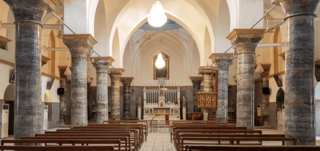
The Assyrian Church of the East, sometimes called Church of the East, officially the Holy Apostolic Catholic Assyrian Church of the East, is an Eastern Christian church that follows the traditional Christology and ecclesiology of the historical Church of the East. It belongs to the eastern branch of Syriac Christianity, and employs the Divine Liturgy of Saints Addai and Mari belonging to the East Syriac Rite. Its main liturgical language is Classical Syriac, a dialect of Eastern Aramaic, and the majority of its adherents are ethnic Assyrians.

Alqosh is a village in the Nineveh Plains of northern Iraq, a sub-district of the Tel Kaif District and is situated 45 km north of the city of Mosul.

The Chaldean Catholic Church is an Eastern Catholic particular church in full communion with the Holy See and the rest of the Catholic Church, and is headed by the Chaldean Patriarchate. Employing in its liturgy the East Syriac Rite in the Syriac language, it is part of Syriac Christianity. Headquartered in the Cathedral of Our Lady of Sorrows, Baghdad, Iraq, since 1950, it is headed by the Catholicos-Patriarch Louis Raphaël I Sako. In 2010, it had a membership of 490,371, of whom 310,235 (63.27%) lived in the Middle East.

Yohannan VIII Hormizd (1760–1838) was the last hereditary patriarch of the Eliya line of the Church of the East and the first patriarch of a united Chaldean Church. After the death of his uncle Eliya XI in 1778, he claimed the patriarchal throne in 1780 and made a Catholic profession of faith. In 1783, he was recognized by the Vatican as patriarchal administrator and archbishop of Mosul. His career as patriarchal administrator was controversial, and was marked by a series of conflicts with his own bishops and also with the Vatican. Suspended from his functions in 1812 and again in 1818, he was reinstated by the Vatican in 1828. In 1830, following the death of the Amid patriarchal administrator Augustine Hindi, he was recognised by the Vatican as patriarch of Babylon of the Chaldeans and the Mosul and Amid patriarchates were united under his leadership. This event marked the birth of the since unbroken patriarchal line of the Chaldean Catholic Church. Yohannan Hormizd died in 1838 and his successor Nicholas I Zayʿa was chosen by the Vatican, ending the centuries-old practice of hereditary succession.
Mar Joseph V Augustine Hindi was the patriarchal administrator of the Chaldean Catholic Church from 1781 to 1827. Since 1804 he considered himself Patriarch with the name of Joseph V and from 1812 to his death he actually governed both the patriarchal sees of Alqosh and Amid of the Church of the East.
Mar Yousip I was the first incumbent of the Josephite line of Church of the East, thus being considered the Patriarch of the Chaldean Catholic Church from 1681 to 1696.
Mar Joseph IV Timotheus Lazar Hindi was the fourth incumbent of the Josephite line of Church of the East, a patriarchate in full communion with the pope mainly active in the areas of Amid and Mardin. He was considered the Patriarch of the Chaldean Catholic Church from 1757 to 1796.

Shimun VIII Yohannan Sulaqa was the first Patriarch of what was to become the Shemʿon line of Chaldean Catholic Church, from 1553 to 1555, after it absorbed this Church of the East patriarchate into full communion with the Holy See and the Catholic Church.

Mar Yohannan Elias Mellus (1831–1908) was a bishop of the Chaldean Catholic Church.

Dioceses of the Church of the East after 1552 were dioceses of the Church of the East and its subsequent branches, both traditionalist and pro-Catholic.

Chaldean Catholic Eparchy of Amadiya was a historical eparchy (diocese) of the Chaldean Catholic Church, until it was united with the Chaldean Catholic Eparchy of Zakho in 2013.
Aqra, properly ʿAqra, is a diocese of the Chaldean Catholic Church founded in the mid-19th century.

Chaldean Catholic Eparchy of Seert was a diocese of the Chaldean Catholic Church, centered in Seert. It existed during the eighteenth, nineteenth and early-twentieth centuries. The diocese was ruined during the First World War.
The Chaldean Catholic Archeparchy of Kirkuk is an archeparchy of the Chaldean Catholic Church in communion with the Pope in Rome. The archeparchy was created in the early years of the nineteenth century. Its present ordinary, Archbishop Yousif Thomas Mirkis, was consecrated in 2014.

Rabban Hormizd Monastery is an important monastery of the Chaldean Catholic Church, founded about 640 AD, carved out in the mountains about 2 miles from Alqosh, Iraq, 28 miles north of Mosul. It was the official residence of the patriarchs of the Eliya line of the Assyrian Church of the East from 1551 to the 18th century, and after the union with Rome in the early 19th century, it became a prominent monastery of the Chaldean Catholic Church.

The Church of the East or the Church of Seleucia-Ctesiphon, also called the Assyrian Church or the Nestorian Church, was an Eastern Christian church of the East Syriac Rite, based in Mesopotamia. It was one of three major branches of Eastern Christianity that arose from the Christological controversies of the 5th and 6th centuries, alongside the Oriental Orthodox Churches and the Chalcedonian Church. During the early modern period, a series of schisms gave rise to rival patriarchates, sometimes two, sometimes three. Since the latter half of the 20th century, three churches in Iraq claim the heritage of the Church of the East. Meanwhile, the East Syriac churches in India claim the heritage of the Church of the East in India.

The Patriarch of the Church of the East is the patriarch, or leader and head bishop of the Church of the East. The position dates to the early centuries of Christianity within the Sassanid Empire, and the Church has been known by a variety of names, including the Church of the East, Nestorian Church, the Persian Church, the Sassanid Church, or East Syrian.

Mar Shemʿon VII Ishoʿyahb, born Īshōʿyahb bar Māmā, was Patriarch of the Church of the East from 1539 to 1558, with residence in Rabban Hormizd Monastery.

Eliya XII was Patriarch of the Church of the East, from 1778 to 1804, with formal residence in Rabban Hormizd Monastery, near Alqosh, in modern Iraq. His birth name was Ishoyahb, and he was the elder son of priest Abraham, who was brother of the previous patriarch Eliya XI (1722-1778). In 1744, Ishoyahb was consecrated as metropolitan, and designated as presumptive successor by his paternal uncle, patriarch Eliya XI, who died in 1778, and Ishoyahb succeeded him, as patriarch Eliya XII. His tenure was marked by a prolonged rivalry with his pro-Catholic cousin Yohannan Hormizd, who also claimed the patriarchal throne. In 1804, Eliya XII died and was buried in the Rabban Hormizd Monastery, as the last patriarch of the senior Eliya line.













